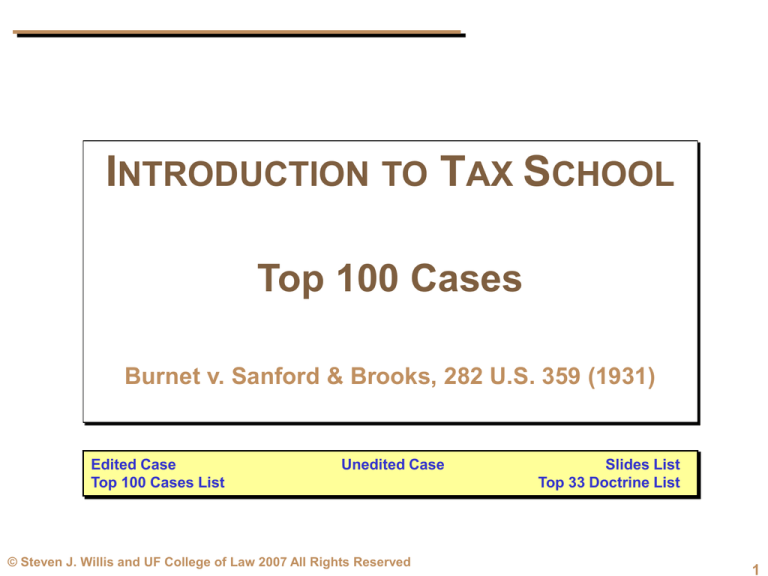
INTRODUCTION TO TAX SCHOOL
Top 100 Cases
Burnet v. Sanford & Brooks, 282 U.S. 359 (1931)
Edited Case
Top 100 Cases List
Unedited Case
© Steven J. Willis and UF College of Law 2007 All Rights Reserved
Slides List
Top 33 Doctrine List
1
Burnet v. Sanford & Brooks, 282 U.S. 359 (1931)
• Sanford & Brooks stands for one important
proposition:
• This proposition is conjunction with two other famous
cases:
– North American Oil v. Burnet, 286 U.S. 417 (1932)
– U.S. v. Lewis, 340 U.S. 590 (1951).
© Steven J. Willis and UF College of Law 2007 All Rights Reserved
2
Burnet v. Sanford & Brooks, 282 U.S. 359 (1931)
• Sanford & Brooks stands for one important
proposition:
Every year stands alone.
• This proposition is conjunction with two other famous
cases:
– North American Oil v. Burnet, 286 U.S. 417 (1932)
– U.S. v. Lewis, 340 U.S. 590 (1951).
© Steven J. Willis and UF College of Law 2007 All Rights Reserved
3
Burnet v. Sanford & Brooks, 282 U.S. 359 (1931)
• Sanford & Brooks stands for one important
proposition:
Every year stands alone.
• This proposition is conjunction with two other famous
cases:
– North
American
Oil v. this
Burnet,
U.S.
417United
(1932)
Another
way
of saying
is286
that
the
– U.S.
v. Lewis,
340rather
U.S. 590than
(1951).transactional
States
uses
annual
accounting.
© Steven J. Willis and UF College of Law 2007 All Rights Reserved
4
Burnet v. Sanford & Brooks, 282 U.S. 359 (1931)
• Sanford & Brooks stands for one important
proposition:
Every year stands alone.
• This proposition is conjunction with two other famous
cases:
– North
American
Oil v. this
Burnet,
U.S.
417United
(1932)
Another
way
of saying
is286
that
the
– U.S.
v. Lewis,
340rather
U.S. 590than
(1951).transactional
States
uses
annual
accounting.
© Steven J. Willis and UF College of Law 2007 All Rights Reserved
5
Burnet v. Sanford & Brooks, 282 U.S. 359 (1931)
• Sanford & Brooks stands for one important
proposition:
Every year stands alone.
• This proposition is conjunction with two other famous
cases:
– North
American
Oil v. this
Burnet,
U.S.
417United
(1932)
Another
way
of saying
is286
that
the
– U.S.
v. Lewis,
340rather
U.S. 590than
(1951).transactional
States
uses
annual
accounting.
© Steven J. Willis and UF College of Law 2007 All Rights Reserved
6
Burnet v. Sanford & Brooks, 282 U.S. 359 (1931)
• Sanford & Brooks stands for one important
proposition:
Every year stands alone.
• This proposition is conjunction with two other famous
cases:
– North
American
Oil v. this
Burnet,
U.S.
417United
(1932)
Another
way
of saying
is286
that
the
– U.S.
v. Lewis,
340rather
U.S. 590than
(1951).transactional
States
uses
annual
accounting.
© Steven J. Willis and UF College of Law 2007 All Rights Reserved
7
Burnet v. Sanford & Brooks, 282 U.S. 359 (1931)
• Sanford & Brooks stands for one important
proposition:
Every year stands alone.
• This proposition is conjunction with two other famous
cases:
– North
American
Oil v. this
Burnet,
U.S.
417United
(1932)
Another
way
of saying
is286
that
the
– U.S.
v. Lewis,
340rather
U.S. 590than
(1951).transactional
States
uses
annual
accounting.
© Steven J. Willis and UF College of Law 2007 All Rights Reserved
8
Burnet v. Sanford & Brooks, 282 U.S. 359 (1931)
• Sanford & Brooks stands for one important
proposition:
Every year stands alone.
• This proposition is conjunction with two other famous
cases:
– North American Oil v. Burnet, 286 U.S. 417 (1932)
– U.S. v. Lewis, 340 U.S. 590 (1951).
© Steven J. Willis and UF College of Law 2007 All Rights Reserved
9
Burnet v. Sanford & Brooks, 282 U.S. 359 (1931)
• Sanford & Brooks stands for one important
proposition:
Every year stands alone.
• This proposition is conjunction with two other famous
cases:
– North American Oil v. Burnet, 286 U.S. 417 (1932)
– U.S. v. Lewis, 340 U.S. 590 (1951).
© Steven J. Willis and UF College of Law 2007 All Rights Reserved
10
Burnet v. Sanford & Brooks, 282 U.S. 359 (1931)
• Sanford & Brooks stands for one important
proposition:
Every year stands alone.
• This proposition is conjunction with two other famous
cases:
– North American Oil v. Burnet, 286 U.S. 417 (1932)
– U.S. v. Lewis, 340 U.S. 590 (1951).
© Steven J. Willis and UF College of Law 2007 All Rights Reserved
11
Burnet v. Sanford & Brooks, 282 U.S. 359 (1931)
• Sanford & Brooks stands for one important
proposition:
Every year stands alone.
• This proposition is conjunction with two other famous
cases:
– North American Oil v. Burnet, 286 U.S. 417 (1932)
– U.S. v. Lewis, 340 U.S. 590 (1951).
These two cases are also
on the top 100 list.
© Steven J. Willis and UF College of Law 2007 All Rights Reserved
12
Burnet v. Sanford & Brooks, 282 U.S. 359 (1931)
• FACTS:
–
–
–
–
Company did work for United States during 1913-16.
Company had net losses during these years of $176,271.88
In 1916, the company sued the U.S. for the money.
In 1920, it collected the $176,271.88 plus interest.1920:
• ISSUE:
– How should the company report the recovery?
– Is it income when received?
– Should the company amend the prior returns to remove the
deducted losses?
– HOLDING:
– The $176,271.88 was income on receipt.
– The prior years correctly reported losses. Amendment of
them would be inappropriate.
© Steven J. Willis and UF College of Law 2007 All Rights Reserved
13
Burnet v. Sanford & Brooks, 282 U.S. 359 (1931)
• FACTS:
–
–
–
–
•
Company did work for United States during 1913-16.
Company had net losses during these years of $176,271.88
In 1916, the company sued the U.S. for the money.
In 1920, it collected the $176,271.88 plus interest.1920:
Note: The case arose very early in our
ISSUE:
tax system: the 16th Amendment
authorizing
the income
tax recovery?
became
– How should
the company
report the
effective in 1913.
– Is it income when received?
– Should the company amend the prior returns to remove the
deducted losses?
– HOLDING:
– The $176,271.88 was income on receipt.
– The prior years correctly reported losses. Amendment of
them would be inappropriate.
© Steven J. Willis and UF College of Law 2007 All Rights Reserved
14
Burnet v. Sanford & Brooks, 282 U.S. 359 (1931)
• FACTS:
–
–
–
–
•
Company did work for United States during 1913-16.
Company had net losses during these years of $176,271.88
In 1916, the company sued the U.S. for the money.
In 1920, it collected the $176,271.88 plus interest.1920:
Note: The case arose very early in our
ISSUE:
tax system: the 16th Amendment
authorizing
the income
tax recovery?
became
– How should
the company
report the
effective in 1913.
– Is it income when received?
– Should the company amend the prior returns to remove the
deducted losses?
– HOLDING:
– The $176,271.88 was income on receipt.
– The prior years correctly reported losses. Amendment of
them would be inappropriate.
© Steven J. Willis and UF College of Law 2007 All Rights Reserved
15
Burnet v. Sanford & Brooks, 282 U.S. 359 (1931)
• FACTS:
–
–
–
–
Company did work for United States during 1913-16.
Company had net losses during these years of $176,271.88
In 1916, the company sued the U.S. for the money.
In 1920, it collected the $176,271.88 plus interest.1920:
• ISSUE:
– How should the company report the recovery?
– Is it income when received?
– Should the company amend the prior returns to remove the
deducted losses?
– HOLDING:
– The $176,271.88 was income on receipt.
– The prior years correctly reported losses. Amendment of
them would be inappropriate.
© Steven J. Willis and UF College of Law 2007 All Rights Reserved
16
Burnet v. Sanford & Brooks, 282 U.S. 359 (1931)
• FACTS:
–
–
–
–
Company did work for United States during 1913-16.
Company had net losses during these years of $176,271.88
In 1916, the company sued the U.S. for the money.
In 1920, it collected the $176,271.88 plus interest.1920:
• ISSUE:
The company
actually
reported
the losses
– How should
the company
report
the recovery?
on its tax returns during 1913-16.
– Is it income when received?
– Should the company amend the prior returns to remove the
deducted losses?
– HOLDING:
– The $176,271.88 was income on receipt.
– The prior years correctly reported losses. Amendment of
them would be inappropriate.
© Steven J. Willis and UF College of Law 2007 All Rights Reserved
17
Burnet v. Sanford & Brooks, 282 U.S. 359 (1931)
• FACTS:
–
–
–
–
Company did work for United States during 1913-16.
Company had net losses during these years of $176,271.88
In 1916, the company sued the U.S. for the money.
In 1920, it collected the $176,271.88 plus interest.1920:
• ISSUE:
The company
actually
reported
the losses
– How should
the company
report
the recovery?
on its tax returns during 1913-16.
– Is it income when received?
– Should the company amend the prior returns to remove the
deducted losses?
– HOLDING:
– The $176,271.88 was income on receipt.
– The prior years correctly reported losses. Amendment of
them would be inappropriate.
© Steven J. Willis and UF College of Law 2007 All Rights Reserved
18
Burnet v. Sanford & Brooks, 282 U.S. 359 (1931)
• FACTS:
–
–
–
–
Company did work for United States during 1913-16.
Company had net losses during these years of $176,271.88
In 1916, the company sued the U.S. for the money.
In 1920, it collected the $176,271.88 plus interest.1920:
• ISSUE:
The company
actually
reported
the losses
– How should
the company
report
the recovery?
on its tax returns during 1913-16.
– Is it income when received?
– Should the company amend the prior returns to remove the
deducted losses?
This reporting treatment was
– HOLDING:
proper.
– The $176,271.88 was income on receipt.
– The prior years correctly reported losses. Amendment of
them would be inappropriate.
© Steven J. Willis and UF College of Law 2007 All Rights Reserved
19
Burnet v. Sanford & Brooks, 282 U.S. 359 (1931)
• FACTS:
–
–
–
–
Company did work for United States during 1913-16.
Company had net losses during these years of $176,271.88
In 1916, the company sued the U.S. for the money.
In 1920, it collected the $176,271.88 plus interest.1920:
• ISSUE:
– How should the company report the recovery?
– Is it income when received?
– Should the company amend the prior returns to remove the
deducted losses?
– HOLDING:
– The $176,271.88 was income on receipt.
– The prior years correctly reported losses. Amendment of
them would be inappropriate.
© Steven J. Willis and UF College of Law 2007 All Rights Reserved
20
Burnet v. Sanford & Brooks, 282 U.S. 359 (1931)
• FACTS:
–
–
–
–
Company did work for United States during 1913-16.
Company had net losses during these years of $176,271.88
In 1916, the company sued the U.S. for the money.
In 1920, it collected the $176,271.88 plus interest.1920:
• ISSUE:
– HowNote:
should
company
reportthe
theU.S.
recovery?
thethe
company
claimed
owed payment for the services equal to
thereceived?
losses.
– Is it income when
– Should the company amend the prior returns to remove the
deducted losses?
– HOLDING:
– The $176,271.88 was income on receipt.
– The prior years correctly reported losses. Amendment of
them would be inappropriate.
© Steven J. Willis and UF College of Law 2007 All Rights Reserved
21
Burnet v. Sanford & Brooks, 282 U.S. 359 (1931)
• FACTS:
–
–
–
–
Company did work for United States during 1913-16.
Company had net losses during these years of $176,271.88
In 1916, the company sued the U.S. for the money.
In 1920, it collected the $176,271.88 plus interest.1920:
• ISSUE:
– HowNote:
should
company
reportthe
theU.S.
recovery?
thethe
company
claimed
owed payment for the services equal to
thereceived?
losses.
– Is it income when
– Should the company amend the prior returns to remove the
deducted losses?
– HOLDING:
– The $176,271.88 was income on receipt.
– The prior years correctly reported losses. Amendment of
them would be inappropriate.
© Steven J. Willis and UF College of Law 2007 All Rights Reserved
22
Burnet v. Sanford & Brooks, 282 U.S. 359 (1931)
• FACTS:
–
–
–
–
Company did work for United States during 1913-16.
Company had net losses during these years of $176,271.88
In 1916, the company sued the U.S. for the money.
In 1920, it collected the $176,271.88 plus interest.1920:
• ISSUE:
– HowNote:
should
company
reportthe
theU.S.
recovery?
thethe
company
claimed
owed payment for the services equal to
thereceived?
losses.
– Is it income when
– Should the company amend the prior returns to remove the
deducted losses?
– HOLDING:
– The $176,271.88 was income on receipt.
– The prior years correctly reported losses. Amendment of
them would be inappropriate.
© Steven J. Willis and UF College of Law 2007 All Rights Reserved
23
Burnet v. Sanford & Brooks, 282 U.S. 359 (1931)
• FACTS:
–
–
–
–
Company did work for United States during 1913-16.
Company had net losses during these years of $176,271.88
In 1916, the company sued the U.S. for the money.
In 1920, it collected the $176,271.88 plus interest.
• ISSUE:
– How should the company report the recovery?
– Is it income when received?
– Should the company amend the prior returns to remove the
deducted losses?
– HOLDING:
– The $176,271.88 was income on receipt.
– The prior years correctly reported losses. Amendment of
them would be inappropriate.
© Steven J. Willis and UF College of Law 2007 All Rights Reserved
24
Burnet v. Sanford & Brooks, 282 U.S. 359 (1931)
• FACTS:
–
–
–
–
Company did work for United States during 1913-16.
Company had net losses during these years of $176,271.88
In 1916, the company sued the U.S. for the money.
In 1920, it collected the $176,271.88 plus interest.
• ISSUE:
– How should the company report the recovery?
Both the taxpayer and the government
– Is itagreed
income
when
received?
the
interest
was taxable in the year
– Should the company
of amend
receipt.the prior returns to remove the
deducted losses?
– HOLDING:
– The $176,271.88 was income on receipt.
– The prior years correctly reported losses. Amendment of
them would be inappropriate.
© Steven J. Willis and UF College of Law 2007 All Rights Reserved
25
Burnet v. Sanford & Brooks, 282 U.S. 359 (1931)
• FACTS:
–
–
–
–
Company did work for United States during 1913-16.
Company had net losses during these years of $176,271.88
In 1916, the company sued the U.S. for the money.
In 1920, it collected the $176,271.88 plus interest.
• ISSUE:
– How should the company report the recovery?
Both the taxpayer and the government
– Is itagreed
income
when
received?
the
interest
was taxable in the year
– Should the company
of amend
receipt.the prior returns to remove the
deducted losses?
– HOLDING:
– The $176,271.88 was income on receipt.
– The prior years correctly reported losses. Amendment of
them would be inappropriate.
© Steven J. Willis and UF College of Law 2007 All Rights Reserved
26
Burnet v. Sanford & Brooks, 282 U.S. 359 (1931)
• FACTS:
–
–
–
–
Company did work for United States during 1913-16.
Company had net losses during these years of $176,271.88
In 1916, the company sued the U.S. for the money.
In 1920, it collected the $176,271.88 plus interest.
• ISSUE:
– How should the company report the recovery?
Both the taxpayer and the government
– Is itagreed
income
when
received?
the
interest
was taxable in the year
– Should the company
of amend
receipt.the prior returns to remove the
deducted losses?
– HOLDING:
Depending
on the
method of
– The $176,271.88
was income
on company’s
receipt.
accounting
plus
variouslosses.
time value
of moneyof
– The prior years
correctly
reported
Amendment
provisions,
this may – or may not – be true today.
them would
be inappropriate.
© Steven J. Willis and UF College of Law 2007 All Rights Reserved
27
Burnet v. Sanford & Brooks, 282 U.S. 359 (1931)
• FACTS:
–
–
–
–
Company did work for United States during 1913-16.
Company had net losses during these years of $176,271.88
In 1916, the company sued the U.S. for the money.
In 1920, it collected the $176,271.88 plus interest.1920:
• ISSUE:
– How should the company report the recovery?
• Is it income when received?
• Should the company amend the prior returns to remove the
deducted losses?
– HOLDING:
– The $176,271.88 was income on receipt.
– The prior years correctly reported losses. Amendment of
them would be inappropriate.
© Steven J. Willis and UF College of Law 2007 All Rights Reserved
28
Burnet v. Sanford & Brooks, 282 U.S. 359 (1931)
• FACTS:
–
–
–
–
Company did work for United States during 1913-16.
Company had net losses during these years of $176,271.88
In 1916, the company sued the U.S. for the money.
In 1920, it collected the $176,271.88 plus interest.1920:
• ISSUE:
– How should the company report the recovery?
• Is it income when received?
• Should the company amend the prior returns to remove the
deducted losses?
– HOLDING:
– The $176,271.88 was income on receipt.
– The prior years correctly reported losses. Amendment of
them would be inappropriate.
© Steven J. Willis and UF College of Law 2007 All Rights Reserved
29
Burnet v. Sanford & Brooks, 282 U.S. 359 (1931)
• FACTS:
–
–
–
–
Company did work for United States during 1913-16.
Company had net losses during these years of $176,271.88
In 1916, the company sued the U.S. for the money.
In 1920, it collected the $176,271.88 plus interest.1920:
• ISSUE:
– How should the company report the recovery?
• Is it income when received?
• Should the company amend the prior returns to remove the
deducted losses?
– HOLDING:
– The $176,271.88 was income on receipt.
– The prior years correctly reported losses. Amendment of
them would be inappropriate.
© Steven J. Willis and UF College of Law 2007 All Rights Reserved
30
Burnet v. Sanford & Brooks, 282 U.S. 359 (1931)
• FACTS:
–
–
–
–
Company did work for United States during 1913-16.
Company had net losses during these years of $176,271.88
In 1916, the company sued the U.S. for the money.
In 1920, it collected the $176,271.88 plus interest.1920:
• ISSUE:
– How should the company report the recovery?
• Is it income when received?
• Should the company amend the prior returns to remove the
deducted losses?
– HOLDING:
– The $176,271.88 was income on receipt.
– The prior years correctly reported losses. Amendment of
them would be inappropriate.
© Steven J. Willis and UF College of Law 2007 All Rights Reserved
31
Burnet v. Sanford & Brooks, 282 U.S. 359 (1931)
• FACTS:
–
–
–
–
Company did work for United States during 1913-16.
Company had net losses during these years of $176,271.88
In 1916, the company sued the U.S. for the money.
In 1920, it collected the $176,271.88 plus interest.1920:
• ISSUE:
– How should the company report the recovery?
• Is it income when received?
• Should the company amend the prior returns to remove
the deducted losses?
– HOLDING:
– The $176,271.88 was income on receipt.
– The prior years correctly reported losses. Amendment of
them would be inappropriate.
© Steven J. Willis and UF College of Law 2007 All Rights Reserved
32
Burnet v. Sanford & Brooks, 282 U.S. 359 (1931)
• FACTS:
–
–
–
–
Company did work for United States during 1913-16.
Company had net losses during these years of $176,271.88
In 1916, the company sued the U.S. for the money.
In 1920, it collected the $176,271.88 plus interest.1920:
• ISSUE:
– How should the company report the recovery?
• Is it income when received?
• Should the company amend the prior returns to remove
the deducted losses?
– HOLDING:
– The $176,271.88 was income on receipt.
– The prior years correctly reported losses. Amendment of
them would be inappropriate.
© Steven J. Willis and UF College of Law 2007 All Rights Reserved
33
Burnet v. Sanford & Brooks, 282 U.S. 359 (1931)
• FACTS:
–
–
–
–
Company did work for United States during 1913-16.
Company had net losses during these years of $176,271.88
In 1916, the company sued the U.S. for the money.
In 1920, it collected the $176,271.88 plus interest.1920:
• ISSUE:
– How should the company report the recovery?
• Is it income when received?
• Should the company amend the prior returns to remove
the deducted losses?
– HOLDING:
– The $176,271.88 was income on receipt.
The appellate court permitted exclusion of the recovery in
– The
prior
correctly reported
losses.
Amendment
1920.
But,years
it conditioned
this opinion
on the
taxpayer of
them would
be inappropriate.
amending
the returns
for 1913-16 to omit the prior expenses.
© Steven J. Willis and UF College of Law 2007 All Rights Reserved
34
Burnet v. Sanford & Brooks, 282 U.S. 359 (1931)
• FACTS:
–
–
–
–
Company did work for United States during 1913-16.
Company had net losses during these years of $176,271.88
In 1916, the company sued the U.S. for the money.
In 1920, it collected the $176,271.88 plus interest.1920:
• ISSUE:
– How should the company report the recovery?
• Is it income when received?
• Should the company amend the prior returns to remove
the deducted losses?
– HOLDING:
– The $176,271.88 was income on receipt.
The appellate court permitted exclusion of the recovery in
– The
prior
correctly reported
losses.
Amendment
1920.
But,years
it conditioned
this opinion
on the
taxpayer of
them would
be inappropriate.
amending
the returns
for 1913-16 to omit the prior expenses.
© Steven J. Willis and UF College of Law 2007 All Rights Reserved
35
Burnet v. Sanford & Brooks, 282 U.S. 359 (1931)
• FACTS:
–
–
–
–
Company did work for United States during 1913-16.
Company had net losses during these years of $176,271.88
In 1916, the company sued the U.S. for the money.
In 1920, it collected the $176,271.88 plus interest.1920:
• ISSUE:
– How should the company report the recovery?
• Is it income when received?
• Should the company amend the prior returns to remove
the deducted losses?
– HOLDING:
But, the
Supreme Court
– The $176,271.88 was income
on receipt.
reversed
thelosses.
appellate
court. of
– The prior years correctly
reported
Amendment
them would be inappropriate.
© Steven J. Willis and UF College of Law 2007 All Rights Reserved
36
Burnet v. Sanford & Brooks, 282 U.S. 359 (1931)
• FACTS:
–
–
–
–
Company did work for United States during 1913-16.
Company had net losses during these years of $176,271.88
In 1916, the company sued the U.S. for the money.
In 1920, it collected the $176,271.88 plus interest.1920:
• ISSUE:
– How should the company report the recovery?
• Is it income when received?
• Should the company amend the prior returns to remove
the deducted losses?
– HOLDING:
– The $176,271.88 was income on receipt.
– The prior years correctly reported losses. Amendment of
them would be inappropriate.
© Steven J. Willis and UF College of Law 2007 All Rights Reserved
37
Burnet v. Sanford & Brooks, 282 U.S. 359 (1931)
• FACTS:
–
–
–
–
Company did work for United States during 1913-16.
Company had net losses during these years of $176,271.88
In 1916, the company sued the U.S. for the money.
In 1920, it collected the $176,271.88 plus interest.1920:
• ISSUE:
– How should the company report the recovery?
• Is it income when received?
• Should the company amend the prior returns to remove
the deducted losses?
– HOLDING:
– The $176,271.88 was income on receipt.
– The prior years correctly reported losses. Amendment of
them would be inappropriate.
© Steven J. Willis and UF College of Law 2007 All Rights Reserved
38
Burnet v. Sanford & Brooks, 282 U.S. 359 (1931)
• FACTS:
–
–
–
–
Company did work for United States during 1913-16.
Company had net losses during these years of $176,271.88
In 1916, the company sued the U.S. for the money.
In 1920, it collected the $176,271.88 plus interest.1920:
• ISSUE:
– How should the company report the recovery?
• Is it income when received?
• Should the company amend the prior returns to remove
the deducted losses?
– HOLDING:
– The $176,271.88 was income on receipt.
– The prior years correctly reported losses. Amendment of
them would be inappropriate.
© Steven J. Willis and UF College of Law 2007 All Rights Reserved
39
Burnet v. Sanford & Brooks, 282 U.S. 359 (1931)
To Repeat:
The Supreme Court required inclusion of the recovery
in 1920 - the year of receipt. Using an amended
return to correct the problem violated the annual
accounting system adopted by Congress.
© Steven J. Willis and UF College of Law 2007 All Rights Reserved
40
Burnet v. Sanford & Brooks, 282 U.S. 359 (1931)
To Repeat:
The Supreme Court required inclusion of the recovery
in 1920 - the year of receipt. Using an amended
return to correct the problem violated the annual
accounting system adopted by Congress.
© Steven J. Willis and UF College of Law 2007 All Rights Reserved
41
Burnet v. Sanford & Brooks, 282 U.S. 359 (1931)
To Repeat:
The Supreme Court required inclusion of the recovery
in 1920 - the year of receipt. Using an amended
return to correct the problem violated the annual
accounting system adopted by Congress.
Congress adopted an annual system,
rather than a transactional system.
© Steven J. Willis and UF College of Law 2007 All Rights Reserved
42
Burnet v. Sanford & Brooks, 282 U.S. 359 (1931)
To Repeat:
The Supreme Court required inclusion of the recovery
in 1920 - the year of receipt. Using an amended
return to correct the problem violated the annual
accounting system adopted by Congress.
Congress adopted an annual system,
rather than a transactional system.
A transactional system could be Constitutional;
however, that is not what Congress chose.
It also would be cumbersome . . . requiring returns for
every transaction!!!
© Steven J. Willis and UF College of Law 2007 All Rights Reserved
43
Burnet v. Sanford & Brooks, 282 U.S. 359 (1931)
To Repeat:
The Supreme Court required inclusion of the recovery
in 1920 - the year of receipt. Using an amended
return to correct the problem violated the annual
accounting system adopted by Congress.
Congress adopted an annual system,
rather than a transactional system.
A transactional system could be Constitutional;
however, that is not what Congress chose.
It also would be cumbersome . . . requiring returns for
every transaction!!!
© Steven J. Willis and UF College of Law 2007 All Rights Reserved
44
Burnet v. Sanford & Brooks, 282 U.S. 359 (1931)
• To summarize:
– When you hear of Sanford & Brooks you should associate
the case with the general rule that
– ould also associate the case with transactional accounting and
the notion that every year stands alone.
• Ideally, you would also associate the case with
– Burnet v. Sanford & Brooks, 282 U.S. 359 (1931)
– U.S. v. Lewis, 340 U.S. 590 (1951).
© Steven J. Willis and UF College of Law 2007 All Rights Reserved
45
Burnet v. Sanford & Brooks, 282 U.S. 359 (1931)
• To summarize:
– When you hear of Sanford & Brooks you should associate
the case with the general rule that
– ould also associate the case with transactional accounting and
the notion that every year stands alone.
• Ideally, you would also associate the case with
– Burnet v. Sanford & Brooks, 282 U.S. 359 (1931)
– U.S. v. Lewis, 340 U.S. 590 (1951).
© Steven J. Willis and UF College of Law 2007 All Rights Reserved
46
Burnet v. Sanford & Brooks, 282 U.S. 359 (1931)
• To summarize:
– When you hear of Sanford & Brooks you should associate
the case with the general rule that
– ould also associate the case with transactional accounting and
the notion that every year stands alone.
Every year stands alone.
• Ideally, you would also associate the case with
– Burnet v. Sanford & Brooks, 282 U.S. 359 (1931)
– U.S. v. Lewis, 340 U.S. 590 (1951).
© Steven J. Willis and UF College of Law 2007 All Rights Reserved
47
Burnet v. Sanford & Brooks, 282 U.S. 359 (1931)
• To summarize:
– When you hear of Sanford & Brooks you should associate
the case with the general rule that
– ould also associate the case with transactional accounting and
the notion that every year stands alone.
Every year stands alone.
• Ideally, you would also associate the case with
– Burnet v. Sanford & Brooks, 282 U.S. 359 (1931)
– U.S. v. Lewis, 340 U.S. 590 (1951).
Another way of saying this is that the United
States uses annual rather than transactional
accounting.
© Steven J. Willis and UF College of Law 2007 All Rights Reserved
48
Burnet v. Sanford & Brooks, 282 U.S. 359 (1931)
• To summarize:
– When you hear of Sanford & Brooks you should associate
the case with the general rule that
– ould also associate the case with transactional accounting and
the notion that every year stands alone.
Every year stands alone.
• Ideally, you would also associate the case with
– Burnet v. Sanford & Brooks, 282 U.S. 359 (1931)
– U.S. v. Lewis, 340 U.S. 590 (1951).
Ideally, you should also associate the case with
•North American Oil v. Burnet, 286 U.S. 417 (1932)
and
•U.S. v. Lewis, 340 U.S. 590 (1951).
© Steven J. Willis and UF College of Law 2007 All Rights Reserved
49







